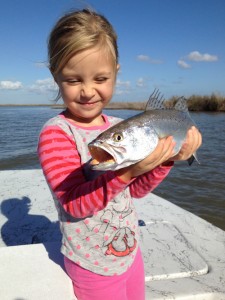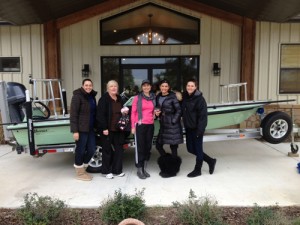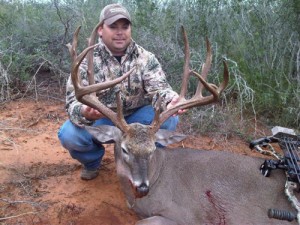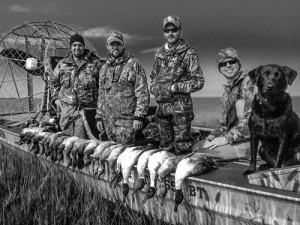Texas anglers, or any anglers who may have visited Texas for any measurable length of time, know that Texas weather can be quite unpredictable. Heck, some folks even say that if you don’t like the Texas weather, just stick around for five minutes and it will probably change. And there’s no place in the state where this is more evident than along the vast stretches of coastline along the Gulf of Mexico. One minute it’s muggy and raining, and the next thing you know the sun is shining – just like nothing ever happened. Another thing Texas coastal anglers know is that the month of December can place them amongst a wide range of cloud, water, wind, and temperature ranges and conditions on any day of the month. The weekend may bring clouds, rain, and blustery winds that help drop temperatures into the 30’s and 40’s for Monday and Tuesday, and then by Wednesday or Thursday the thermometer climbs back into the 70’s, or maybe even the low 80’s. Times like these can be very frustrating for anglers, especially for those who don’t get to spend a lot of time out on the water. When this happens to you, utilizing a little common sense based upon your prior experiences can help you save an otherwise dreary day.
Let me use a recent trip of mine to help explain what I mean. It was a couple days following a very substantial cold-front which had made its way down to the Coastal Bend region all the way from Canada. And although the winds and the rain had already blown past us, there remained a great deal of cloud cover – I couldn’t see a star in the sky while I was prepping the boat before sunrise. As I made my way across the bay to what has proven to be a good place for me locating cold-water trout over the years, I could also tell that the water color wasn’t what I’d hoped it would be. The strong winds accompanying the frontal passage had significantly muddied the water, at least out in the open-water of the bay. It was just as the sky was brightening that I arrived at the location. I eased the boat close to the protected shore where I knew it would be shallow enough to start my first wading session. I still couldn’t see very well, so I just dropped the anchor and sat to enjoy the quiet for a few more minutes.
The air was still extremely cold, and a dunk of my hand into the water next to the boat told me the water temperature had dipped also. A few minutes had passed, and I could now clearly see down the shoreline for quite some distance. I could also now tell that the cloud cover appeared as though it might be breaking up. As I looked out across the water, I never saw any “signs” of action, at least not at the surface. However, I knew that the bay floor beneath me tapered away from the shoreline into about a six-to-eight foot depth. Experience told me that the fish were going to be cold this morning, and that if I remained patient, this shoreline that is covered with a brief topping of mud, grass, and shell might just come alive at the first hint of sunshine. So, I tied-on a dark, slow-sinker mullet imitation and made my way into the water. Due to the coldness of the water, I knew the fish would be nibbling at my bait, so I began working the lure at a painstakingly slow pace across the mid and lower portions of the water column. I persevered in this fashion for the next half-hour with no results, and had made my way out into waist-deep water that was not exceedingly clear.
The sun had since peered from behind the clouds and was now beaming down strong upon the shallow water at my back. I knew that once the sun began to shine, the water along the bank would begin to warm much faster than out deep where I was, so I slowly started my way back to skinnier water. As I walked, I attached one of my favorite bottom-dwelling plastic tails to the end of my line and began broadcasting my presentation of the bait in patterns from my nine o’clock to my three o’clock, all the while attempting to create a small mud cloud across the bay floor directly behind the path of my lure. I got to about thigh-deep water when I got my first strike. It was brief, and I think it took me off-guard to the point to where I simply got too excited and jerked the rod tip way too fast.
The sky was blue, and the sun was bright now, and the hits just kept coming from the very shallow water as the morning progressed. I fished until about noon, and ended the trip with a half-dozen sizeable trout. Even managed a small flounder? Anyhow, I’m convinced that I was only able to do as well as I did that morning because I relied on what I had learned from experience, and because I was able to force myself to be patient enough to take advantage of the conditions as they changed around me.
We hope everyone has a safe and happy Christmas holiday, and we want you to remember that this year’s annual Bay Flats Lodge 2014 Winter Fishing Special is just around the corner. It’s a time during the months of January, February, and March when you and your guests can fish at the Lodge and receive our standard fishing package at a tremendously discounted rate. Remember to practice CPR, “Catch, Photo, and Release”, whenever possible on trophy Trout and Reds…Guide Chris Martin, Port O’Connor/Seadrift region. www.BayFlatsLodge.com…1-888-677-4868








